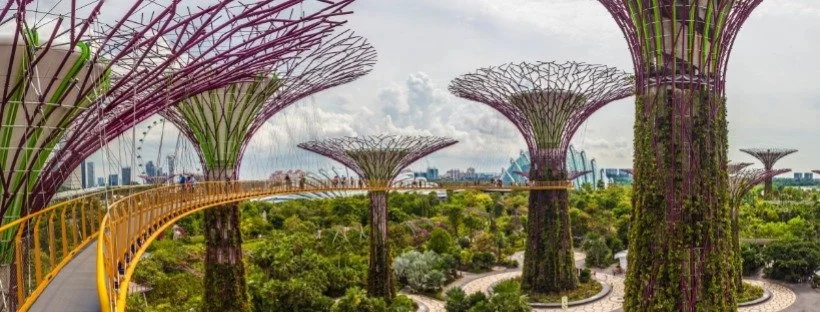The City in a Garden: Meet the Future of Metropolises
By: Kaila Morris
In Singapore’s Supertree Grove, fifty-meter-high gardens tower above the sidewalks like trees–– but rather than having a woody composition, each trunk is fortified by surpluses of vibrant plants. This latticework of flowers and ferns awes visitors as it travels upwards, branching off into a scientific beauty: a canopy of metal branches, curved like an inverted umbrella, that converts sunlight into energy.
The grove is only one piece of a much larger, self-sustainable park in Singapore. The park, called Gardens by the Bay, offers us a view into what our cities could look like in half a century. And indeed, it’s only been fifty-six years since Singapore was founded as a city-state dominated by pollution and overpopulation–– and even less since they began their green industrialization.
Singapore’s sustainability journey is an inspiring one. In 1965, they separated from Malaysia following severe political differences between the two ruling parties. The tensions had escalated into racial riots, and on the morning of August 9, the Malaysian Parliament voted to allow Singapore to separate themselves from the federation. It was a unanimous decision, but it did not come without consequences. At the time, Singapore suffered from many of the urban challenges that still predominate large cities today–– without much funding to address them. However, then Prime Minister Lee Kuan Yew recognized the pertinence of the problem and did what he could to address it. The government began to introduce new environmental policies into the city, acquiring more land; forming action committees; and maximizing the resources that were available, like water and clean air.
In addition to their early start and continued persistence, Singapore’s sustainability success could perhaps be credited towards a willingness to make sacrifices. Though allowing large corporations to expand without regard to the environment would be more economical and efficient in the short-term, for example, Lee recognized the importance of holding all companies accountable to the same sustainability guidelines. When the firm Sumitomo built Singapore’s first petrochemical plant, they still had to follow the regulations put in place to control pollution. Lee also spent valuable money to clean the contaminated Singapore River, which had previously teamed with toxins. At the time, it was an expensive campaign. Today, the value of the decision shows: the river is a beloved tourism destination and favored area for nighttime strolls.
All in all, it’s safe to say that Singapore takes sustainability seriously–– and that’s only just the beginning. From pure rivers and verdant green spaces like Gardens by the Bay, to energy-generating trees and energy-efficient transportation systems, it’s amazing to imagine the futuristic city becoming more advanced in time. But Singapore is already looking towards the future with the Singapore Green Plan.
At its core, the plan hopes to more closely align Singapore with the larger United Nations Sustainable Development Goals. Highlights include the planting of one million more trees, greater coherence between people and wildlife, quadrupled solar energy, carbon neutrality in 20% of schools, and 30% reduced waste in landfills. And all by 2030. In less than a decade, the “City in a Garden” may resemble something beyond our wildest dreams. More idealistic Singaporeans are imagining a world in which self-driving taxis, high-speed rail lines, and solar-powered floating platforms for ships are the norm.
These advancements may be awe-inspiring for the rest of us, but they are not out of reach. Singapore’s success story proves that self-sustainability is achievable for our present cities. Achieving a greener, more equitable future is not only reliant on the resources we have available to us, but how we can utilize them to the best of our abilities. Despite having a less-than-prosperous start, Singapore did what they could to prioritize the country’s development. Though that required upfront sacrifices, their actions paid off (quite literally-- the tourism industry, whose growth can be attributed in part to Singapore’s futuristic look, contributed almost $18 billion to Singapore’s national GDP in 2017, or 4.1%). Singapore’s success also teaches us that we must always be forward-thinking. Though our minds are wired to think in the short-term, it is important to put aside greed and instant gratification to achieve our sustainable development goals. When we do, it becomes evident that the largest economic and social returns come when we extend our efforts over a longer period of time.
So, how does Singapore stand out? Commendable resource management and a willingness to make small sacrifices for a much greater reward. Truly, one of the biggest obstacles standing between our cities’ current states and Singapore’s own is human nature, which defies both. When we can acknowledge that growth requires an upfront investment, and favor rationality over greed and gut inclinations–– then perhaps our own gardens will live in the sky.


